Lab 17 - Deuterostomes
1/97
Earn XP
Description and Tags
BIO 112 - Dr. Shauna Price
Name | Mastery | Learn | Test | Matching | Spaced |
|---|
No study sessions yet.
98 Terms
What is the pattern of development of a deuterostome?
Unlike protostomes, the mouth of the organism develops AFTER the anus from the blastospore.
What does the development of a multicellular organism involve?
Mitosis, cell differentiation, and morphogenesis.
What is mitosis?
A form of cell division.
What is cell differentiation?
The process of cells becoming different from each other, ex: nerve vs muscle vs bone cells.
What is morphogenesis?
The movement of cells to different positions that leads to the formation of the shape of tissues, organs, and the organism itself.
What is the first stage of deuterostome development?
Unfertilized egg.
What are the characteristics of the unfertilized egg stage of deuterostome development?
A large cell with the nutrients and organelles necessary for an early embryo, including a visible nucleus and nucleolus.
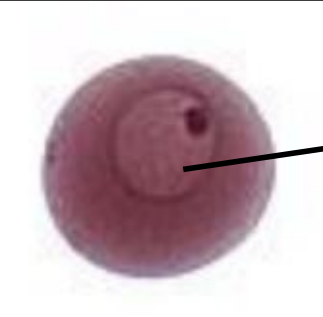
What does this image show? What is the arrow pointing to? What is the dark spot?
The unfertilized egg stage of a deuterostome organism, the arrow points to the nucleus and the dark spot is the nucleolus.
What is the process of going from the first stage of deuterostome development to the second called?
Fertilization.
What is the second stage of deuterostome development?
The zygote.
What are the characteristics of the zygote stage of deuterostome development?
It’s the first diploid cell of the developing organism where the nucleus is not visible and has a fertilization envelope to prevent more sperm from entering the egg.
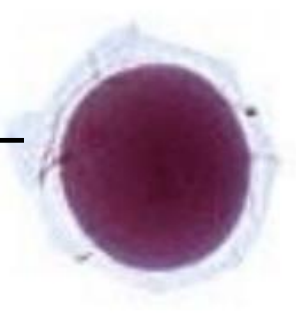
What does this image show? What does the arrow point to?
The zygote stage of a deuterostome organism, the arrow points to the fertilization envelope.
What is the process of going from the second stage of deuterostome development to the third called?
Cleavage.
What does the cleavage process entail?
It is a series of cell division where the egg’s cytoplasm is divided into smaller cells (they double so go from 2 to 4 to 8 etc). however this process does NOT grow the size of the embryo itself.
What is the third and fourth stage of deuterostome development?
The 2 and 4 cell stage.
What are cells called during the cleavage process as well as in third and fourth stage of deuterostome development?
Blastomeres.
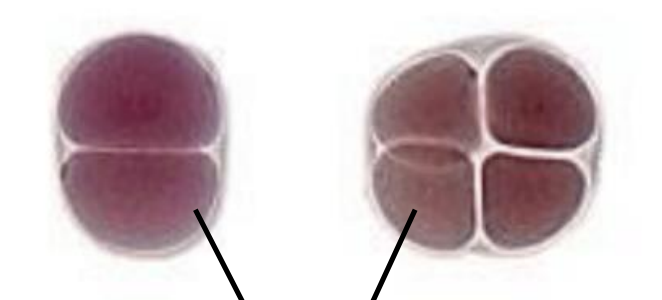
What does this image show? What are the arrows pointing to?
The 2 and 4 cell stage of a deuterostome organism, the arrows are pointing to the blastomeres.
What is the fifth stage of deuterostome development that is also brough by cleavage?
The morula stage.
What are the characteristics of the morula stage of deuterostome development?
A solid ball of cells, considered the morula when it has 8 or more cells.
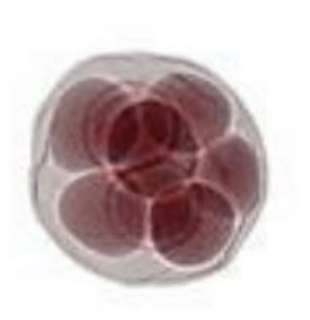
What is this image showing?
The morula stage of a deuterostome organism.
What is the sixth stage of deuterostome development?
The early blastula stage.
What are the characteristics of the early blastula stage in deuterostome development?
A hollow ball of cells that are formed and organized into a single outer layer with a fluid-filled center.
What is the process of reorganization of cells into s single outer layer called?
Morphogenesis.
What is the center of the blastula stage called?
The blastocoel.
What is the seventh stage in deuterostome development?
The late blastula stage.
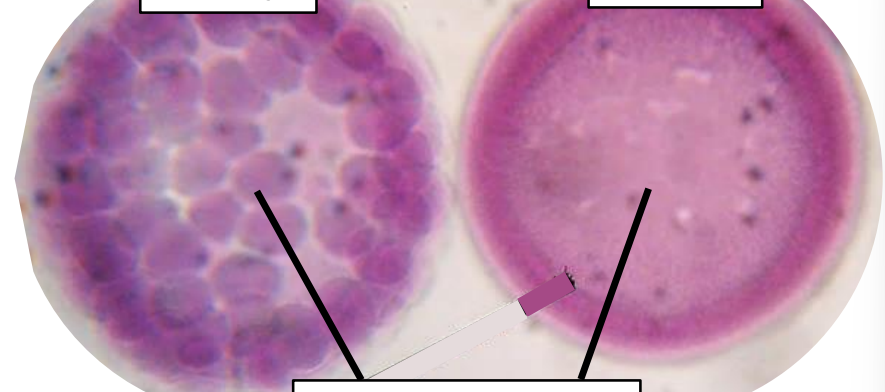
What cell is in the early blastula stage? Why?
The right cell is the early stage blastula because it still has visible center cells.
What is the process of going from the seventh stage of deuterostome development to the eighth called?
Gastrulation.
What does gastrulation entail?
Formation of the gastrula from the blastula.
What is the eight stage of deuterostome development?
The early gastrula.
What is a gastrula?
A multilayered cell stage that contains three germ layers (endo-, meso- and ectoderm) due to differentiation and migration of cells.
What is the ninth stage in deuterostome development?
The late gastrula stage.

What does this image show? What are the arrows pointing to (top to bottom, left to right)? Which cell is in the earlier stage?
Cells in the gastrula stages of deuterostome organisms, the arrows show the blastocoel, early archenteron, and blastospore, the earlier stage gastrula is the cell on the left.
What is the archenteron?
A hollow tube that forms into the digestive tract of a deuterostome organism.
What is the blastopore?
The opening of the archenteron that (in deuterostomes) becomes the anus of the organism.
What is the last stage of deuterostome development?
The larval stage.
What are the characteristics of the larval stage of deuterostome development?
Larvae kinds/names vary from species to species so there is no definitive characteristics.
What are the characteristics of the Phylum Echinodermata?
Marine organisms which have evolved traits for them to be able to live on the ocean floor, are spikey-skinned, and have bilateral symmetry as larvae, contains about 7,000 species.
What do the “spikes” on organisms in the Phylum Echinodermata come from?
Bony plates under their skin.
What are the biological characteristics of the Phylum Echinodermata (development, body cavity, etc)?
They go through deuterostome development, are triploblastic, coelomates with a complete digestive system.
What are organisms in the Phylum Echinodermata called?
Echinoderms.
Unlike the Echinoderms larvae, the adult organism are not bilaterally symmetrical, why?
As they develop, the left side of the organism grows and the right gets absorbed.
What kind of symmetry do the adult Echinoderms have? What does it mean?
They have pentaradial symmetry which means they are arranged in 5 parts around a central axis.
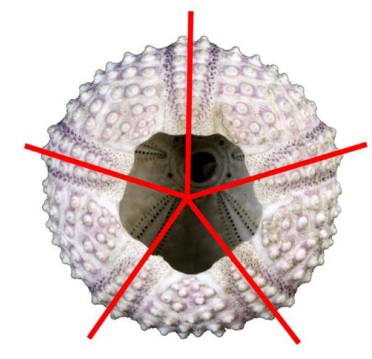
Do Echinoderms have segmentation?
Since they have the gene for segmentation embryos do but adults do not.
What is the nervous system of Echinoderms?
They lack cephalization and a central nervous system so they have nerve rings with radial nerves with sense organs concentrated at the tips or their arms.
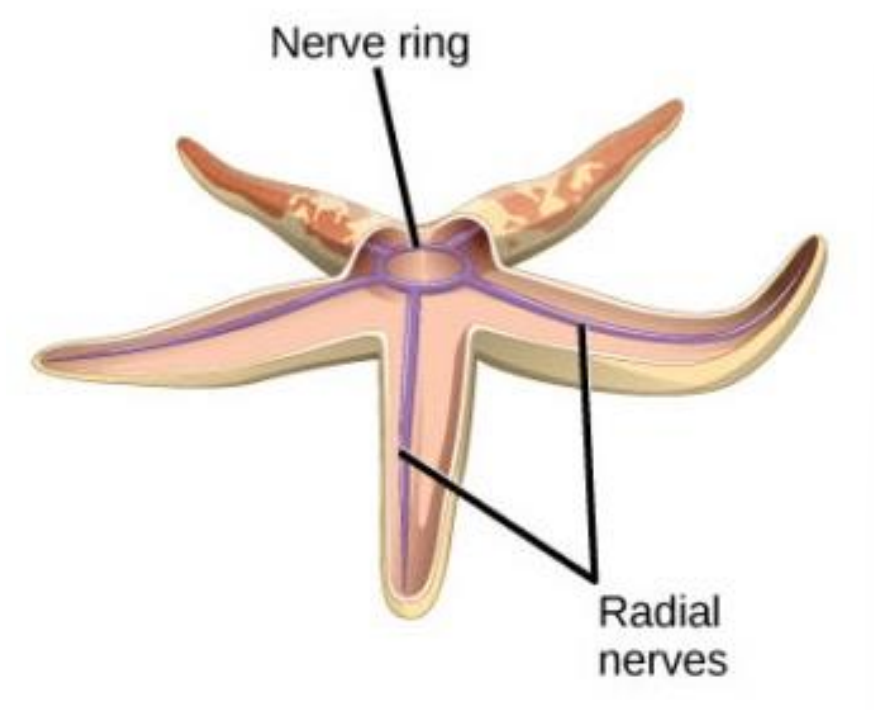
What sense organs do Echinoderms have?
Eyes, chemical detectors, and touch receptors.
What unique characteristics do Echinoderms have?
Water vascular systems and dermal skeletons.
What structures do water vascular system have in Echinoderms? What is this system derived from?
Derived from the coelom, it have tube feet.
What is the water vascular system in Echinoderms used for?
Locomotion, circulation, gas exchange (paired with gills), excretion of nitrogen waste, and sensing.
What do nutrients circulate in the water vascular systems of Echinoderms?
Fluid.
What is diffusion in Echinoderms?
The form of nitrogen excretion.
What are tube feet specialized for?
Sensing and locomotion.
What is the dermal skeleton of Phylum Echinodermata made up of? Where are they?
Made up of calcium carbonate elements, they are an internal skeleton embedded within the skin.
What are the calcium carbonate elements in dermal skeletons of Echinoderms called?
Ossicles.
What variations could the ossicles in the dermal skeletons of Echinoderms have?
They could be in different arrangements like fused or jointed as well as different forms like spines, plates or bumps.
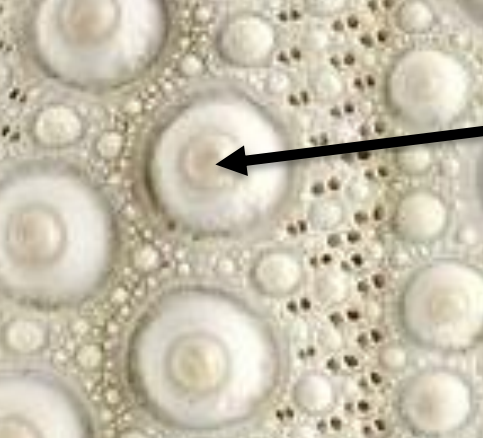
What is the arrow pointing to in a sea urchin? What are they for?
Bumps as part of the dermal skeleton that is used for spine attachment.
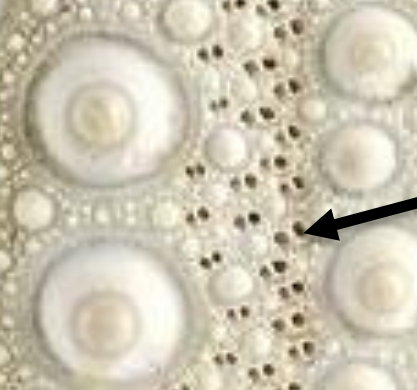
What is this arrow pointing to in a sea urchin? What are they for?
Holes/pores in the dermal skeleton that are used for tube feet to come out of.
What are the 5 classes in the Phylum Echinodermata?
Class Crinoidea
Class Ophiuroidea
Class Echinoidea
Class Holothuroidea
Class Asteroidea
What are the characteristics of the Class Crinoidea?
Filter feeding organism that are flowerlike with many thin branched arms, filter feeders.
What are the common names for some organisms in the Class Crinoidea?
Feather stars and sea lilies.
What are the characteristics of the Class Ophiuroidea?
Most are scavengers on small particles, are made up of a central disc with 5 thin arms that allow rapid movement and swimming.
What is the common name of some the animals in the Class Ophiuroidea?
Brittle stars.
What are the characteristics of the Class Echinoidea?
Grazer feeding organisms that eat algae, have a rigid skeleton made up of interlocking plates with spines sticking out that move around.
What are common names for some of the organisms in the Class Echinoidea?
Sea urchins and sand dollars.
What are the characteristics of the Class Holothuroidea?
Scavengers organisms that use modified tube feet to eat, they are soft-bodied with reduced skeletons, have feeding tentacles, and expel intestines as an anti-predator defense.
What is a common name for some organisms in the Class Holothuroidea?
Sea cucumbers.
What are the characteristics of organisms in the Class Asteroidea?
Predatorial organisms who live in shallow water and have a body made up of a central disc with (usually) 5 arms coming out of it.
What are some common names for organisms in the Class Asteroidea?
Starfish and sea stars.
Why are populations of organisms in the Class Asteroidea declining?
Likely decreased due to O2 availability which leads to lesions and body fragmentations or death.
What are the two surfaces of a starfish called?
Oral (ventral) and aboral (dorsal).
What is the oral surface of a starfish made up of?
The spines, tube feet, arms, and the mouth.
What is a unique adaptations that starfish do with their stomach?
They push their stomach out of their mouth to engulf prey and secrete enzymes.
What is the aboral surface of a starfish contain?
Central disc, madreporite, anus, and arms.
What is the madreporite?
A sieve-like plate that lets water in and out.
What are the components of the water vascular system in a starfish?
Internal canals, tube feet, ampullae, and madreporite.
What are the three kinds of internal canals in starfish?
Stone, ring, and radial.
What are the ampullae of a starfish?
The bulbs on the tips of the tube feet with adhesive disks.
When the ampulla contracts what happens to the tube foot?
When contracted, it forced fluid into the tube feet which lengthens it which causes the adhesive disk to adhere to the ground.
What happens to the tube feet when the adhesive disk releases?
The tube foot contracts which forces fluid into the ampulla, shortening the foot.
What are the characteristics of the Phylum Chordata?
They are SUPER varying, they have bilaterally symmetrical, deuterostomes, triploblastic, coelomates, with compete digestive systems, and closed circulatory systems, most have cephalization, some way to excrete waste, and use either lungs or gills for gas exchange.
What are the 4 key characteristics that ALL chordates share at some stage of development?
Dorsal hollow nerve cord, notochord, pharyngeal slits and a post anal tail.
What is a notochord in Chordates?
A dorsal rod that is rigid but flexible.
What are the function of a notochord in Chordates?
For support, muscle attachment, and signals surrounding tissues during development.
What does the notochord turn into in Chordate vertebrates?
Parts of the backbone.
What are the pharyngeal slits in Chordates like? What are they supported by?
They are small slits in the pharynx that are supported by bars/aches.
What are the pharyngeal slits used for in non-vertebrates? In vertebrates?
In non-vertebrates they are used for filter feeding and in vertebrates they develop into gills, jaws, or inner ears.
What is the post-anal tail in Chordates?
Elongation of the body that extends beyond the anus.
What are post-anal tails used for in Chordates?
Locomotion, balance, and communication.
What are characteristics of the Subphylum Cephalochordata?
Filter feeders that live on the sandy bottoms of the ocean, and the adults have all of the 4 development characteristics.
What organism is in the Subphylum Cephalochordata?
Lancelets.
What is the order of structures in which water flow goes through in organisms in the lancelets?
Mouth/buccal cavity → gills slits → atriopore.
What is the movement of food in a lancelets?
Mouth → pharynx → intestine → anus.
What are the characteristics of Subphylum Urochordata?
Marine, sedentary filter feeders what are covered by a protective cover called the tunic made up of proteins and cellulose.
What is the organism studied in the Subphylum Urochordata? What is its common name?
Tunicates, also called sea squirts.
What are the characteristics of the larval stage of Sea Squirts?
Free-swimming with all 4 development characteristics (dorsal hollow nerve chord, pharyngeal slits, notochord, post-anal tail).
What are he characteristics of the adult stage of Sea Squirts?
Sedentary organisms that lack a noto- and nerve chord with a tail that use their pharyngeal slits and siphons for filter feeding.
What is the largest subphylum in the Class Chordata?
Vertebrata.
What are the characteristics of the Subphylum Vertebrata?
Most have anterior skulls enclosing a large brain, well-developed circulatory systems, rigid internal skeletons, and extensive muscular systems.
What do the features of organisms in the Subphylum Vertebrata support?
Large, active animals and allow for the evolution of many species in different environments.